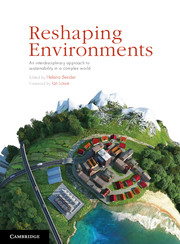Book contents
- Frontmatter
- Contents
- Contributors
- Acknowledgements
- Introduction Reshaping environments – an opportunity for envisioning the future
- Part 1 Cases
- 1 Costa Rica’s dry north-west
- 2 Reshaping land transport in Singapore
- 3 Evaluating different ways of managing forested landscapes
- 4 Changing the landscape management paradigm with farmers
- 5 Meeting development goals without blowing your carbon budget
- 6 The EGLE has landed
- 7 Reshaping the Murray-Darling Basin, Australia
- 8 Burning questions
- Part 2 Skills
- Part 3 Theory
- Index
- Plate Section
- References
7 - Reshaping the Murray-Darling Basin, Australia
Progress in river basin management
from Part 1 - Cases
Published online by Cambridge University Press: 05 February 2013
- Frontmatter
- Contents
- Contributors
- Acknowledgements
- Introduction Reshaping environments – an opportunity for envisioning the future
- Part 1 Cases
- 1 Costa Rica’s dry north-west
- 2 Reshaping land transport in Singapore
- 3 Evaluating different ways of managing forested landscapes
- 4 Changing the landscape management paradigm with farmers
- 5 Meeting development goals without blowing your carbon budget
- 6 The EGLE has landed
- 7 Reshaping the Murray-Darling Basin, Australia
- 8 Burning questions
- Part 2 Skills
- Part 3 Theory
- Index
- Plate Section
- References
Summary
Introduction
The Murray-Darling Basin (referred to below as the ‘Basin’) covers one-seventh of mainland Australia and is considered the most significant river basin in Australia for both its agricultural production and riverine ecosystems (Figure 7.1). The Basin supports highly valued and iconic floodplain habitats spread across its lowland regions; these are extensive and diverse, including 16 wetlands listed under the (Ramsar) Convention on Wetlands of International Importance and critical habitat for 95 state- and Commonwealth-listed fauna species (Murray-Darling Basin Authority 2010a). It also supports substantial agricultural production for consumption within Australia and overseas. Both of these, and many related beneficial functions, are critically dependent on the same water delivered by the Basin’s large rivers (Grafton et al. 2011).
A decade of Basin-wide drought at the start of the 21st century has reinforced the nation’s determination to reshape how water is managed. An increasing volume of irrigation water has been allocated over the 20th century at the expense of freshwater-dependent ecosystems. The impacts have been severe for both ecosystems and irrigators. The inability to meet the water needs of irrigators and other users in the Basin makes the current system unsustainable. The Basin communities and responsible authorities are now facing the task of resolving the over-extraction of water through a Basin-wide water resource plan (the ‘Basin Plan’) (Murray-Darling Basin Authority 2010b).
- Type
- Chapter
- Information
- Reshaping EnvironmentsAn Interdisciplinary Approach to Sustainability in a Complex World, pp. 167 - 186Publisher: Cambridge University PressPrint publication year: 2012



